
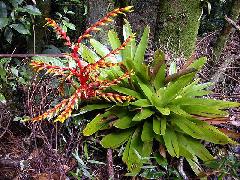
Vriesea seidel 981. < - > Vriesea triligulata
Photographs by Derek Butcher and Oscar Ribeiro
Click for larger image in new screen.
Coming Events.
September 10th Tillandias - Mounting and potting.
October 8th Neoregelia concentrica and its hybrids.
November 11th 9am-4pm Plant Sale.
November 12th Offset swaps and Plant Auction.
July meeting from the Secretary’s desk.
Only the young need apply! Apparently Rio de Janeiro Botanic gardens are looking for young overseas bromeliad students to get some real work experience. An ideal way would be for a Bromeliad Society to act as a sponsor to cover travel costs. What a great opportunity if we were all younger. It was felt that our own Adelaide Botanic Gardens could well be interested in such a scheme and this will be referred on.
Winter Brag caught Adam a bit off guard because some of our faithfuls could not get to the meeting and he expected less to talk about!
The first off the rack were Nidularium which are a great provider of winter colour. Maureen Hick has brought in N. ‘Elfriede’ which is a blast from the past. It is a large plant with variegated leaves and a red centre that is a little raised in the leaf rosette. The petals are blue. It’s history traces back to the early years of our Society when Ede Schaefer kept us all on our toes. After he died, this variegated Nidularium emerged with label lost and we just had to call the plant after his wife, Elfriede. Another large plant is N. angustifolium which Margaret Butcher had brought in. When coming into flower in April it had a large inflorescence, raised some 15cm from the centre of the leaf rosette. The narrow primary bracts up to 15cm long formed a flattened star around the inflorescence, giving it a striking appearance mainly green but with a red suffusion. By July the flowers were still coming and the primary bracts were now a brilliant red. Well worth the wait.
Our new member from Strathalbyn, Geoff Jarrett, surprised us by bringing in a N. innocentii var. lineatum. Why surprise? Well, he had been confiding in the Secretary he grew his plants outside under the trees and we know how cold Strathalbyn can get. He did let slip that this plant was growing in a conservatory type area!
Colin Anderson brought in a flowering Vriesea ‘Seidel 981’ which meant little to him. When collecting plants in the wild many collectors give the collection a number before it is identified and given a name. 9 years ago I had a shot at Herb Plever in New York at the wrong name on his Vriesea triligulata. We kept investigating the anomaly between the plant and its original description and traced it back to 1985 when Seidel sent the plant to Selby Gardens who identified it as V. triligulata. Meanwhile Elton Leme had found a proper V. triligulata which did not have tri-ligules (or petal appendages). It was agreed that the linking of Seidel 981 to V. triligulata was in error but what to do with Seidel 981 which was clearly a new species? The Brazilian taxonomists promised to rectify the matter but alas I think it has become a case of ‘Manana’! I am sure that the wrong Vriesea triligulata is still being grown in Queensland but they are not as fussy as we are as to identity.


Billbergia vittata is not any old Billbergia with cross markings on the leaves. In fact identity of plants is mainly based on the attributes of the flower as Linnaeus taught us 300 years ago but some of us are slow learners! Once we had convinced Maureen that her plant worthy of a brag was the TRUE Billbergia vittata we felt we were getting somewhere. The problem was that Maureen was not awake at the June meeting when I pontificated on Billbergia. In the last Gazette you will have read about my comments that there are many plants circulating under the name ‘vittata’ but which have B. amoena in their make-up. The leaves do not have decent spines and the sepals are a wishy pink and there is just a trace of a floral bract. I hope most of you really looked closely at the B. vittata with its strong black spines, vibrant pink sepals and a floral bract you could easily see.
Did you realise that Tillandsia guatemalensis was known as Tillandsia cyanea for some 100 years before Lyman Smith in 1949 saw differences and corrected the anomaly. My inflorescence at 1 metre was not as tall as Adam’s but a brighter red! Mine had been kept on the dry side and no fertilizer but Adam’s moister and ?more fertilizer. In any event both of us had bought these plants at the March Show having come from Victoria. We will make the most of such magnificent flowering specimens because we are not certain if we will get offsets. We could have made certain of offsets by removing the inflorescence but that would have negated the brag!
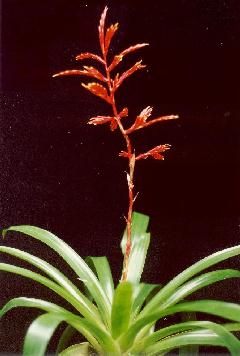
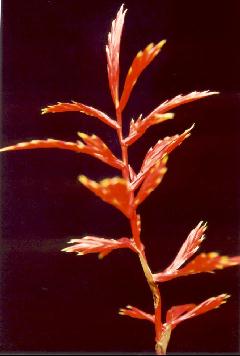
Another odd pupper was also in flower – Vriesea elata from Len Colgan. Here again you can sacrifice the flower because invariably the only offset comes up next to the floral scape. To remove it you have to dismantle the rest of the plant to a pile of leaves. A truly collectors item where patience is a virtue!
Aechmea purpurea-rosea must be popular this time of year because two people had brought in a flowering plant. Perhaps it is spiny but that is one of its charms and if grown properly you get an upright vase from the leaves not a sprawling prickly monster.
Vriesea bleherae is a pleasant species with a certain charm with its dark leaves and yellow inflorescence. I know that Vriesea hieroglyphica is also a great plant known for its hieroglyphic markings on its leaves. Regrettably it is outnumbered these days by hybrids of it. One such was an early John Arden hybrid of V. bleherae x hieroglyphica on display. John was trying to get a good flowerhead on a tessellated leaved plant and did not quite succeed. His later hybrids show how his technique has improved. His hybrids are generally large and showy and therefore not suitable to the European market BUT fantastic for us Aussies with a bit more roomy shadehouses. It is interesting that this hybrid was named 20 years ago as Vriesea ‘Elvira’ but use of the parentage formula persists. The cynic in me suggests that this is the way you can sell the same plant twice.
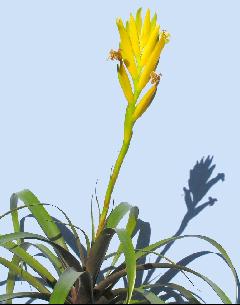
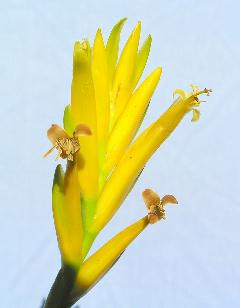
Adam then pointed out several similar looking hybrids with links to Deroose and the European market. For example Vriesea ‘Charlotte’ a great little plant with a colourful large inflorescence and its look alike ‘Tawi’ which came to Australia from Deroose via the Philippines – they just changed the name! Add to this ‘Chieftain’ with a similar look about it. The problem was that there seemed to be slight differences even with the same name on the label. To my mind this is caused by meristemming and lack of quality control in Australia. Adam must be regretting asking me about meristemming and tissue culture because when I get caught on the hop I tend to waffle. I hope the following is a clearer explanation.
We know plants offset to produce clones and if you remove these early you can get lots of offsets, one per leaf axil but the older offsets get weaker and weaker. Let us say you want to confuse this growing tissue by the use of chemicals into thinking it should not produce one offset but to keep multiplying. You then have to stop this crazy behaviour by the use of different chemicals to make this tissue realise it is really a bromeliad. When do you stop this multiplying? In theory you could go on forever and have thousands of the things but as I said, things go wrong with later proper offsets and the same applies here. The greedy ones keep multiplying. The prudent ones stop early. When these clones flower they should in theory be identical but we know for the European market Deroose and the like, destroy thousands of plants not up to scratch. This does not happen in Australia. All they are doing in the laboratory is work with embryos which also occur in seed!
It was great seeing a flowering Guzmania acorifolia. In fact it was the first time I had seen a species Guzmania ever since Keith Bradtberg gave up the challenge over 10 years ago. What we do see are boring look-a-like hybrids either looking like G. lingulata or wittmackii. Some have no labels where it is impossible to link with named cultivars. To think there are over 200 species of Guzmania and so few people in Australia want to grow any of them.
This prompts me to mention a topic that is being given air by the Bromeliad Society International. The view is that we should be encouraging conservation of Bromeliads before all the forests are destroyed. My view is that it is a fantastic aim but somehow the whole mental approach by Bromeliad growers has to change from one of where the hybridist reigns supreme irrespective of the quality of his/her exploits to one of concern for the species. Is there a way where the so-called ability of hybridists can be channelled to production of species? Do you believe in conservation of Bromeliads?
Adam seemed more concerned with the size of his Portea alatisepala whereas David Kruszewski and I were more interested in its identity. The difficulty with separating Portea from Aechmea is the presence of a slender pedicel. How can you tell the difference between a pedicel and a branch when the floral bract is minute as it was in this case. I am sure some hybrids between Aechmea and Portea are thrown in here just to confuse us. Bill Treloar and myself have a laugh about his Portea leptantha where I even have Harry Luther on side in saying it is really a hybrid! Back to Portea alatisepala which has an interesting history. First the plant was discovered in 1977 but was not named until 15 years later. One would think the herbarium specimen was somewhat tattered after this time! Meanwhile in 1986 Elton Leme had a photograph in the BSI Journal of a Portea silveirae which was later thought to be Aechmea grandibracteata and then considered to be the long awaited Portea alatisepala.
One observation is that while those from Brisbane may have an abundance of bromeliads they are not that interested in proper identity which means I am always wary of names on plants from this area.
Even species Portea are difficult to identify purely because we never know where the plant was originally collected.
And so to the surfeit of tillandsias where T. stricta dominated. It was good to see Peter Hall bringing in a T. incarnata in spike which engendered a bit of discussion in that it appeared this species liked growing in Adelaide but needed light to induce flowering. Don’t just leave it hanging around in some dark corner. Len Colgan had a fasciculata x xerographica in spike and only when he explained the differences between it and the species T. xerographica were we able to appreciate these subtleties. If ever he lost the label I know what it would be identified with because there is no write up on this crossing. Perhaps Len will do the same as Tillandsia ‘Fireworks’ from Dimmitt and grandfather in this hybrid with a cultivar name. Certainly John Arden who is supposed to have done the hybrid did not think it worthy of registering and one wonders how it escaped.
Finally, little green Mexicans where we had Tillandsia atroviridipetala on display which had one flower out but so small even David Kruszewski could not see it. The other was not in flower but had come from Tonala in Mexico. I had got my plant from the Buchanans in Northern NSW in 1988 which shows that TILLANDSIA GROWERS ARE PATIENT PEOPLE. Recent correspondence with Renate Ehlers suggests this may be a T. plumosa var curvifolia or is it T. atroviridipetala var curvifolia? Renate did ask what side of the canyon did it come from and all I could say that from memory it was in the large shadehouse halfway down on the right.
As Len Colgan said, Renate had sent me a selection of plants from this group in appreciation of all the translating to English I had done for her and Len was only the courier. We await what comes out of quarantine.
August meeting from the Secretary’s desk
Those who like attending Bromeliad conferences are in for a treat so start saving up.
2007 Sept 21-23 at Port Macquarie, NSW
2008 probably June 17-23 World Conference at Cairns
2009 probably April 10-13 at Adelaide. If anyone wants details please contact the Secretary.
Bill Treloar had the job of talking on plants brought in for display. Even though we had played down the importance of this part of the proceedings because of our special presentation of Bolivian tillandsias there were over 20 different plants brought in.
First there were Aechmea, Orthophytum, and Vriesea. A Vriesea hybrid that Len Colgan brought in had been in his collection for many years having come from John Arden in California. It was now coming into spike. It is interesting that if your Vriesea does decide to flower in the winter time it does tend to get a lean to face the winter sun levels. So it pays to turn your plant if you are a fussy grower wanting all scapes to be strictly erect. We have still to see the plant in full flower but it promises well. You could tell that the plant has a certain rarity because it is known by formula and if John Arden has several of the same clone he usually registers a cultivar name. This may be good or bad! We wait with baited breath.
Now to the other extreme. We had an Aechmea ‘Big Beauty’ on display which looked awfully like an Aechmea recurvata var recurvata to me. There are 24 different sorts of Aechmea recurvata registered where some people see differences from the species but ‘Big Beauty’ is not even one of them. It all comes down to seeing a difference and naming a plant to distinguish it from others so it can be sold. However, if these differences are not recorded, you are lost as to its proper identity. I had to smile (otherwise I would have gritted my teeth) when I saw an advertisement in Garden Express Catalogue complete with photo for a ‘Billbergia chantinii hybrid’ at some substantial price. If you see a species name with n. n after it, it means nomen nudum and is ignored by all good taxonomists. This is why I use N.N after a hybrid name meaning Nurserymen’s Name and should likewise be ignored by all discerning gardeners. The proper thing to do is Register and therefore show the cards in your hand!
Were the tillandsias grown in pots brought in too early because they should be on hand for the September meeting when the various ways of growing tillandsias will be our main talk? My view is that these plants may grow faster in pots but somehow lose their charm if not given some medium where they can look as they may well be found in the wild.
Len Colgan brought in a flowering Tillandsia bella which looked so like a T. aeranthos. It all stems from the recent work of Teresia Strehl from the State of Rio Grande do Sul in Brazil. There are not many tillandsias in this State but Teresia is keen to describe as many different ones as she can. If you are interested and want to find tillandsias in the wild in Rio Grande do Sul, these are the sorts you would be looking for, ignoring the species that look very much like T. aeranthos.
Key to Tillandsia aeranthos
1. Petals dark blue - - - - 2
1a Petals other colours - - 3
2. Floral bracts yellow green - - - - -var.albeobracteata
2a Floral bracts rosy red - 5
3. Petals white - - - - - - 4
3a Petals clear pink - - - - - - - - - var. rosea
4. Floral bracts pale yellow - - - - - var. flava
4a Floral bracts white - - - - - - - - var. alba
5. Floral bracts to 2cm long - - - - - var. aeranthos
5a Floral bracts to 2.7cm long - - - - var. aemula
Finally Bill Treloar has to bring in his two plants he claims are T. bergeri from the same clump but grown in different positions, WHEN they are in flower. I am forever the doubting Thomas.
Finally we have a report of the final segment of the meeting written by Len himself. It is the first time for many years you will be reading something written other than by me!
The rest of the meeting involved the president repeating the presentation that he had delivered at the recent BSI World Conference in San Diego in June. This talk illustrated all of the tillandsias of Bolivia alphabetically from A to Z, excluding the tiny plants of the diaphoranthema subgenus. It comprised 152 slides in a Powerpoint presentation. Where many different forms of a particular species had been collected from diverse locations, each was represented to show such variation. Significant examples of this were T. cardenasii, T. duratii, T. lorentziana, T. streptocarpa, T. vernicosa and T. xiphioides.
The first group of pictures included maps and Google satellite images with key place-names superimposed. This enabled those in the audience who were unfamiliar with the geography of Bolivia to have some appreciation of the territory covered by Len during his 1993 and 2004 expeditions through the Andes mountains and beyond, as well as the habitats where the tillandsias live. He pointed out that, although the majority of pictures were taken by himself, he had to ask a number of other tillandsia buffs for pictures of particular species so that all were represented. Unfortunately, a few that had been received via email were of low resolution, especially when projected onto the large screen. Nevertheless, they were included for the sake of completeness.
Brief information was provided on each of the species, with occasional anecdotes concerning their discovery, collection or the person after whom they were named. Some of the highlights included:
- A new discovery T. aff. argentina found by Roberto Vasquez in Chuquisaca.
- New colonies of the relatively unknown T. calochlamys, found west of Comarapa, and also near Moro Moro, which are both hundreds of kilometers from the type location.
- T. carnosa var. boliviensis, collected alongside the road from Quime to Inquisivi in the Yungas. For such a large plant with a spectacular inflorescence, it is amazing that this habitat was unrecorded, especially considering this dirt road is the only pathway over the high mountains into that region.
- T. colganii, the species discovered by Len in 1993, and subsequently named in his honour. It seems ironic that such a small species should be named after “big Len”. But he is proud of it.
- T. comarapaensis. The form that Len collected in 1993 around Aiquile, and available from a couple of overseas nurseries, is plain when compared to a beautiful unrecorded form collected near the track to Pasorapa.
- The newly described T. dorisdaltoniae, named after a financial benefactor of the Bolivian biodiversity organization Fundacion Amigos de la Naturaleza (FAN), Doris Dalton, rather than a tillandsia enthusiast or expert.
- In addition to the common form of T. edithiae, with lepidote grey leaves, red floral bracts and red petals, we saw a rare form with green leaves and orange flowers. This was followed by another new discovery by Roberto Vasquez of a plant with an appearance similar to an elongated T. sphaerocephala but with a flower head vaguely similar to T. edithiae, again with red floral bracts and red petals. Its eventual classification is unclear.
- The rare T. erici was shown growing in habitat as well as flowering in Len’s collection. The large orange flowers, reminiscent of T. xiphioides but non-fragrant, brought oohs and ahs from the audience. It was mentioned that Derek, Adam and others had small seedlings of this desirable species.
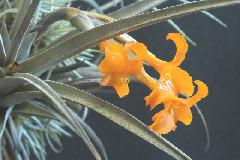
- The not-easy-to-grow T. hasei was illustrated in habitat and in flower. For those questioning its difference from T. argentina, a convenient slide from Renate Ehlers then appeared to dismiss any doubts concerning its authenticity.
- After Len stopped for a rest after climbing a considerable distance towards the location of T. hegeri, he took a picture aimed much higher up in which one could barely distinguish Ewald Heger but not the plants growing on the cliffs. Clearly, Len still had a long distance to climb, but the ensuing pictures of this species made the effort worthwhile. He mentioned that this was the nearest species botanically to T. colganii and was used in the differential diagnosis in the latter’s description.
- A brand new species T. jarmilae had to be added at the last minute to the presentation delivered in San Diego. It was described in the Czech Republic, and the botanist kindly emailed two pictures. With the blue colour of the flowers appearing too extreme to be natural, a not-so-subtle comment was made concerning the capabilities of Adobe Photoshop in modern computers.
- Len was delighted to have received from Lieselotte Hromadnik (Lotte to her friends) a picture of herself in expeditionary clothes alongside T. lotteae at one of its habitats. This plant is considered by some experts to be endangered, and no longer exists at the type locality. However, both Lotte and Len know a number of unpublished locations of this desirable species, thereby ensuring its survival in Bolivia.
- Amazingly, the huge and spectacular T. samaipatensis was not named until 1996 when it was described by Walter Till. With its massive bright yellow inflorescence and violet flowers, this species adorns the cliffs overlooking the main road from the biggest provincial city Santa Cruz westward towards the capital city, La Paz. In 2004, almost all large plants were in flower. One can only assume that tillandsia aficionados prior to 1990, say, had not been down that path at an appropriate time.
- T. streptocarpa was the most prevalent tillandsia species in Bolivia, with millions of plants spread over several provinces. It is common also in collections and nurseries, with fragrant lavender-and-white flowers. Len also displayed another form recorded with pure white flowers, as well as the subspecies T. streptocarpa var. aureiflora. However, arguably the highlight of his 2004 expedition occurred alongside a new track from the village of Moro Moro down to the Rio Mizque. From a single tree, with long extension rods connected to other extension rods, he was able to knock down a number of clumps of T. streptocarpa. Much to his amazement, these clumps included flowering plants at anthesis with vastly different colours in the petals. There were white-coloured flowers, as well as rich dark violet, yellow-gold, yellow-brown, yellow-orange and peach. Who can explain such an amazing discovery ?
- Roberto Vasquez had provided prior information about a stream where he had collected what is most certainly a new species, T. cf. tenuifolia. It occurs in two forms, with white and violet flowers respectively. Sadly, like all of the other plants from the 2004 trip, they were never released by the Bolivian government to come to Australia. But the extensive diversity of Bromeliads along this stream has provided Len with memories forever.
- Of special interest was a plant collected in southern Bolivia during the 1993 trip. It is caulescent, with red-brown bracts yielding fragrant iris-like white flowers with blue spotting. Len hypothesized that it might be a natural hybrid between the wide-spread white flowering T. xiphiodes and T. yuncharaensis which has red bracts and similar fragrant blue flowers. Both occur in that general vicinity.